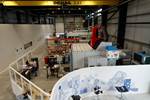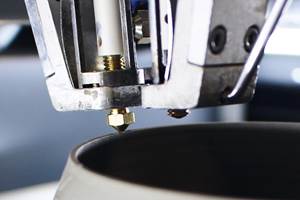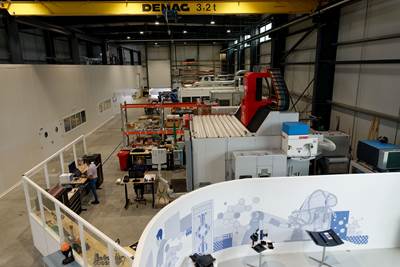New market report predicts size of aerospace sector
MarketsandMarkets has released a report detailing aerospace composites usage to 2019.
The report, "Aerospace Composites Market by Type & Application - Global Trends & Forecasts to 2019", published by MarketsandMarkets (Dallas, TX, US), defines and segments the aerospace composite market with an analysis and forecast for types and applications by volume as well as value. Early buyers will receive 10% customization on this report.
According to the report, Europe, North America, and the Asia-Pacific region dominated the aerospace composite market in 2013 and accounted for over 85% of the market, by volume and value. Country-wise, the U.S. is the top consumer of aerospace composite products globally. Companies, such as Hexcel and Cytec Aerospace Materials are two of the biggest players in the country. France is the second-largest aerospace composite consumer in the world.
The need for lightweight and fuel-efficient aircraft has shifted the focus of manufacturers towards aerospace composites. Future growth in the international market hinges heavily onto developing economies, especially in Asia-Pacific. China and India, especially, stand out as noteworthy emerging markets. The future scenario in Asia-Pacific looks promising given the number of facility expansions, merger and acquisitions, and strategic partnerships that took place in these countries. The ensuing increase in foreign investments and rise in the number of new manufacturing establishments will see Asia-Pacific emerge into a prime driver of growth for the aerospace composite market.
Commercial aircraft took the topmost position in the aerospace composite market with around 61.7% market share by value in 2013. The drive towards fuel-efficient and lightweight aircraft is anticipated to drive the market for aerospace composites. The fastest growth rate till 2019 in the aerospace composite market is projected to come from applications, such as military aircraft and business and general aviation. The growing concern over security issues and the consequent defense spending is anticipated to propel the market. Glass fiber composites comprise approximately 89.6% of the total aerospace composite market in terms of volume. High corrosion resistance, lighter weight, and good tensile strength are some of the reasons for which manufacturers consider glass fiber reinforced composites as an able substitute for metals.
Low-cost airlines have proved to be strong competitors to the luxury airliners, particularly in the developing economies of Asia and Latin America during the 2008-2009 economic downturns. The highest traffic growth in particular was in the short-haul routes around Southeast Asia, India and Australia. In India, low-cost carriers Spice Jet and Indigo continue to grow as they replace the likes of Air India, Jet Airways and Kingfisher Airlines. Even major airlines like Jet and Kingfisher converted 70% of their domestic operations to the low-cost model in the past couple of years.
Boeing and Airbus also predicted that the companies would require approximately 5,200 new airliners in the 100 to 210 seat category, such as the best-selling A320 family. In 2012 low-cost carriers like Indigo, Spice Jet and JetLite ordered 46 new aircraft, which are to be delivered by the end of 2014. This increasing market for airlines is a good indicator that the market for aerospace composites will thrive in the future, says the report.
Aerospace composite manufacturers are focused on expansion with key objective of catering growing demand with better penetration in the emerging economies. For instance, Toray Industries Inc. (Japan) invested around $450 million to increase global carbon fiber production capacity by 6,000 KT annually in its Japan, U.S., France, and South Korea sites during 2014 and 2015.
The growing demand for light-weight aerospace has encouraged other companies to adopt the strategy of expansion like Toray Industries, along with other strategies such as partnerships, new product development, agreements, joint ventures, and collaborations. Market players are focusing on expansions of production facilities.
Related Content
Plant tour: Aernnova Composites, Toledo and Illescas, Spain
RTM and ATL/AFP high-rate production sites feature this composites and engineering leader’s continued push for excellence and innovation for future airframes.
Read MoreWelding is not bonding
Discussion of the issues in our understanding of thermoplastic composite welded structures and certification of the latest materials and welding technologies for future airframes.
Read MoreA new era for ceramic matrix composites
CMC is expanding, with new fiber production in Europe, faster processes and higher temperature materials enabling applications for industry, hypersonics and New Space.
Read MoreLow-cost, efficient CFRP anisogrid lattice structures
CIRA uses patented parallel winding, dry fiber, silicone tooling and resin infusion to cut labor for lightweight, heavily loaded space applications.
Read MoreRead Next
Plant tour: Daher Shap’in TechCenter and composites production plant, Saint-Aignan-de-Grandlieu, France
Co-located R&D and production advance OOA thermosets, thermoplastics, welding, recycling and digital technologies for faster processing and certification of lighter, more sustainable composites.
Read More“Structured air” TPS safeguards composite structures
Powered by an 85% air/15% pure polyimide aerogel, Blueshift’s novel material system protects structures during transient thermal events from -200°C to beyond 2400°C for rockets, battery boxes and more.
Read MoreComposites end markets: New space (2025)
Composite materials — with their unmatched strength-to-weight ratio, durability in extreme environments and design versatility — are at the heart of innovations in satellites, propulsion systems and lunar exploration vehicles, propelling the space economy toward a $1.8 trillion future.
Read More











